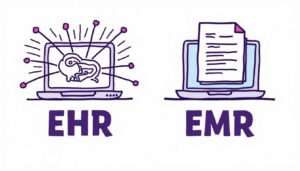How a Healthcare Virtual Assistant Can Solve Burnout and Boost Patient Care
27 May 2025 By: Mary Dellosa
Updated

Healthcare workers face heavy stress from managing many tasks. A healthcare virtual assistant (HVA) offers strong support. They cut down admin work and boost patient care. This help reduces provider burnout. This article shows how healthcare virtual assistants fight burnout and improve care.
The Growing Challenge of Burnout in Healthcare
Burnout is now common in healthcare, hitting workers in all roles. Long hours, paperwork, and emotional strain often drain their energy fast.
Understanding Burnout
Burnout is characterized by emotional exhaustion, depersonalization, and a diminished sense of personal accomplishment. Healthcare professionals often experience this due to long hours, high patient loads, and the pressure to provide exceptional care. The consequences can be dire, not only for the providers but also for the patients they serve.
Impact on Patient Care
Burned-out providers may offer lower-quality care. Burnout can raise error rates, drop patient satisfaction, and cause more staff to quit. This leaves others overwhelmed.
Burnout also weakens emotional connection. Providers may miss patient cues and communicate poorly. Patients feel ignored, which can slow healing and raise costs.
Addressing the Issue
Spotting burnout early helps fix the problem. Many hospitals now use wellness plans to build worker strength. These include mindfulness, peer talks, and flexible hours.
Focusing on mental health makes work better. It helps staff feel supported and improves care. A strong system helps both workers and patients thrive.
The Role of Healthcare Virtual Assistants
Healthcare virtual assistants (HVAs) handle admin work in medical settings. They free up providers to focus fully on patient care. In a fast-paced field, healthcare virtual assistants boost workflow and save time. Their support improves how clinics run and raises overall care quality.

Administrative Support
Healthcare virtual assistants manage tasks like scheduling, follow-ups, and health records. This gives providers more time and cuts their load. Less pressure means fewer mistakes and more focus on care. They help teams stay organized, leading to better patient results.
Enhanced Patient Communication
Healthcare virtual assistants boost patient contact by handling questions, reminders, and follow-ups. This keeps care personal and improves the patient experience. Using calls, texts, and emails, HVAs keep patients informed. Clear, steady contact raises satisfaction and helps patients follow care plans.
Data Management and Compliance
Healthcare virtual assistants also manage private patient data and follow health laws. They handle records safely, keeping patient trust strong and meeting rules. By keeping records tidy and current, HVAs help avoid legal issues. Their skills speed up billing and support a clinic’s financial health.
Support During High-Demand Periods
Healthcare virtual assistants give key help during busy times like flu season. They handle the spike in calls and bookings so providers don’t get overwhelmed.
This support lowers stress and keeps care steady. Patients still get timely help, even when demand surges.
How HVAs Alleviate Burnout
When healthcare virtual assistants join healthcare teams, burnout often drops. They take on routine tasks, freeing up providers to focus on patient care. With fewer distractions, staff can work more carefully and make fewer mistakes.
Time saved on admin duties gives providers more chances to connect with patients. During busy periods, healthcare virtual assistants offer much-needed support, easing pressure on the whole team. This smoother workflow helps reduce stress and boost morale across the board.
Time Management
Time is vital for healthcare workers. Healthcare virtual assistants keep schedules in order, giving providers space for both patient care and personal rest. This balance protects mental health and helps stop burnout.
They also sort tasks by need, so professionals can focus on the most important work. This smart use of time boosts output and lowers stress. It builds a healthier, lasting work-life rhythm.
Focus on Patient Care
When healthcare virtual assistants handle admin work, providers can focus fully on patients. This sharper focus leads to better care, with stronger diagnoses and treatment plans. With less stress, providers show more empathy and build deeper connections.
Patients feel heard and trusted, which helps them speak openly about their health. This trust boosts care quality and creates a cycle where both patients and providers benefit.
Boosting Patient Care with Healthcare Virtual Assistants
Besides easing burnout, healthcare virtual assistants also raise care quality. They make healthcare smoother and more supportive. By blending tech with a human touch, Healthcare virtual assistants link admin work to patient needs. This frees up providers to focus fully on patient health and care.

Personalized Patient Experiences
HVAs collect patient info before visits, helping providers prep ahead. This saves time and makes patients feel seen and valued. When patients feel cared for, trust and satisfaction rise.
Healthcare virtual assistants also track history and preferences, letting providers tailor care to each person. This personal touch builds stronger bonds and encourages open talk and treatment follow-through.
Streamlined Processes
Healthcare virtual assistants automate routine work, speeding up healthcare tasks. This cuts wait times and helps care reach patients faster. With smoother systems, resources get used better, helping both staff and patients.
They handle bookings, reminders, and refills, giving providers more time for detailed care. This leads to a better flow and quicker responses. Plus, the data Healthcare virtual assistants gather shows patient patterns, helping clinics improve services over time.
Implementing Healthcare Virtual Assistants
To add HVAs smoothly, healthcare teams should plan carefully. Start by choosing tasks the healthcare virtual assistants will handle, like scheduling or records. Train staff to work with the assistant and set clear rules for use.
Use secure tech to protect patient data and follow health laws. Monitor the setup and gather feedback to fine-tune the process. With the right steps, healthcare virtual assistants can boost care and cut stress.
Identifying Needs
Before adding healthcare virtual assistants, healthcare teams must assess their needs. Pinpoint which tasks can be handed off and what challenges staff face daily. This review helps choose the right tools and support. Patient age and service type also matter.
Clinics serving seniors may need help with reminders and bookings. Pediatric clinics might need healthcare virtual assistants skilled in family-friendly chats. Tailoring them to each setting ensures smoother use and better results.
Training and Integration
After setting clear needs, training is key for both healthcare virtual assistants and staff. Everyone must know the healthcare virtual assistant’s role and how to work with it smoothly. Start small and adjust as needed.
Set up feedback systems so staff and patients can share thoughts. Their input helps improve tools to fit changing needs. Keep training going to teach staff about updates. This builds a team that adapts fast and keeps care strong.
Success Stories: HVAs in Action
Many healthcare groups now use HVAs and see big gains. Providers feel less stress, and patient care improves. Tasks run smoother, errors drop, and staff have more time for real care.
Patients also feel the difference with faster help and better support. These wins show that HVAs can truly lift both staff well-being and service quality.
Case Study 1: A Family Practice
A suburban family clinic struggled with burnout from high patient loads and admin stress. They brought in an HVA to handle scheduling and follow-ups. In six months, staff burnout dropped by 30%. Providers felt more present with patients, and satisfaction scores rose. The Healthcare virtual assistant also set up a digital system to track visits, cutting no-shows by 15%. This made the clinic more efficient and gave staff more time to care for each patient. Both the team and the patients felt the change.
Case Study 2: A Specialty Clinic
A chronic care clinic used Healthcare virtual assistants to answer patient questions and lead outreach. This freed providers to focus on tough cases and build custom care plans. Patients followed treatments better, which led to fewer hospital visits and stronger health. HVAs also ran workshops that taught patients about their conditions. Patients felt more in control and trusted their care teams more. The clinic saw a big rise in engagement, with many patients thankful for the extra help. Healthcare virtual assistants helped build a full-circle approach to chronic care.
Challenges and Considerations
Despite clear benefits, onboarding healthcare virtual assistants comes with some challenges. One key concern is data security. Healthcare virtual assistants must handle patient info safely and follow health laws. Any breach can hurt trust and lead to legal trouble.
Another issue is training. Staff and HVAs need time to learn how to work well together. Poor setup can cause confusion or slow service. Also, some patients may prefer face-to-face help and feel unsure about virtual support. It’s vital to balance tech use with personal care. With careful planning, these hurdles can be managed, letting Healthcare virtual assistants reach their full potential.

Data Privacy and Security
Healthcare groups must protect data when adding Healthcare virtual assistants. Healthcare virtual assistants need strong training in HIPAA rules and safe info handling to keep trust and stay legal. Using tech like AI adds more risk, so data must stay correct and secure. Clinics should set up strong cyber defenses and check systems often. Regular audits help stop breaches and keep patient data safe.
Maintaining Quality of Care
As Healthcare virtual assistants take on more tasks, tracking care quality is key. Feedback from staff and patients helps check if they improve the experience. Clear goals and metrics show how well Healthcare virtual assistants perform. Training should focus on strong communication and patient support. This builds teamwork and keeps care centered on patients. Ongoing learning helps HVAs stay current with health trends. With these steps, HVAs can keep raising care standards.
Trending Now
Nearly half of U.S. doctors feel burned out, down slightly from last year but still above pre-COVID levels. Many now cut hours or leave jobs to cope. While 24% face depression, most believe work-life balance is still possible. Younger doctors report better balance and improved personal relationships. Most doctors now view self-care and hobbies as key to mental health, and many would trade pay for balance.
Physician burnout dropped to 45.2% in 2023 from a peak of 62.8% in 2021, showing signs of progress. Yet, doctors still face higher burnout than other workers, mainly due to long hours, administrative loads, and the effects of COVID-19. Many report lower satisfaction with work-life balance and risk leaving the field. Groups like the AMA push for system-wide change through programs, tools, and conferences. Still, experts warn that real improvement needs stronger action, policy reform, and better health care system support.
The Future of Healthcare with Virtual Assistants
As healthcare needs grow, Healthcare virtual assistants will take on bigger roles. Tech progress will make them even more useful and deeply tied to care systems. HVAs may soon help with remote monitoring, AI-driven insights, and real-time patient support. Their role will keep evolving, offering smart, fast help in new ways. This shift will boost care quality and ease the load on providers.
Telehealth and Remote Support
As telehealth grows, HVAs help run virtual visits smoothly. They book, prep, and follow up with patients at home. This boosts access and eases pressure on clinics.
AI and Automation
With AI and automation advancing, HVAs will become even more efficient. They’ll automate tasks and use AI to study patient data. This tech shift will boost care and speed.
Conclusion
Healthcare virtual assistants do more than admin work, they’re key allies in care. They ease burnout and raise care quality, making systems stronger and more lasting. As healthcare changes, HVAs help build a better balance for staff and patients. The future of care blends smart tools with true support for all.
Want to cut staff burnout and boost care? HelpSquad health is ready to help. Our trained virtual assistants and 24/7 support team handle healthcare tasks with ease. With bilingual agents from $8.50/hr, you get expert help without high costs. Start your trial now and see the HelpSquad difference!


